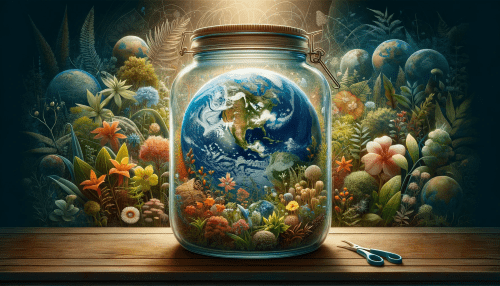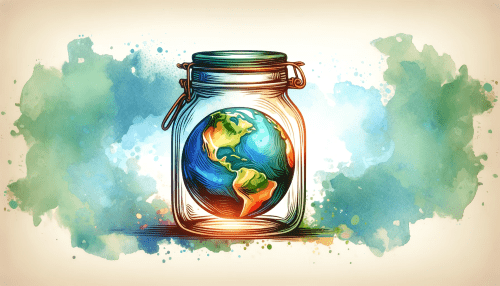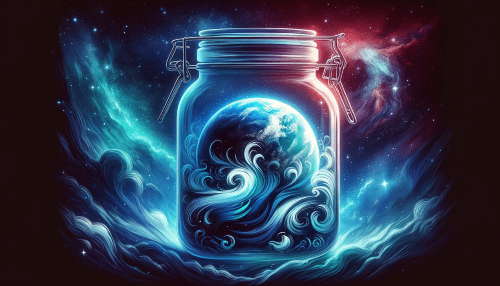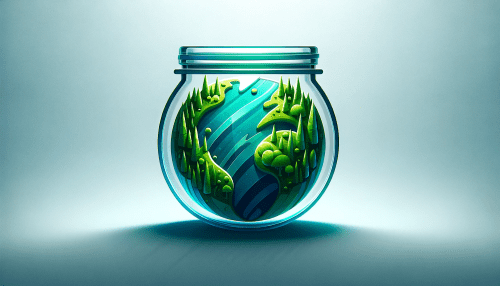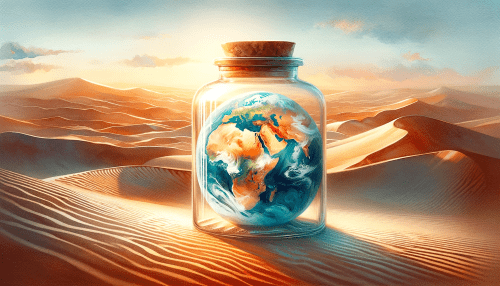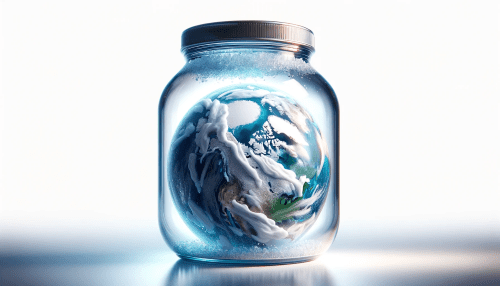Introduction:
In the grand tapestry of existence, every thread is essential, every hue significant. “Life in a Jar: An Artistic Examination of Social Isolation” is a poignant exploration of these connections, depicted through the visual metaphor of Earth ensconced within glass. As viewers, we are drawn into a realm where the fragility of our planet is juxtaposed with its overwhelming beauty, encapsulating the diversity of life in a series of jars. This art series implores us to contemplate the barriers we erect—both physical and metaphorical—and the impact of our self-imposed isolation on the natural world.
Each artwork, in this new set of artworks, part of the “Life in a Jar” art project, serves as a vignette, a captured moment where Earth’s boundless variety is displayed in a jar. From the teeming life visible in the lush greens of forests to the vibrant dance of marine ecosystems, these pieces are a testament to the planet’s resilience and the abundance it offers. Yet, they also pose a question: what becomes of a world kept in isolation? The jars, while offering a clear view of their contents, are a barrier—a delicate, glass separation between us and the very life we are part of.
Through these powerful images, the artist invites us on a journey of reflection. We are encouraged to see beyond the surface, to recognize the intricate interdependencies that sustain us. This project, at its core, is a conversation about balance—the balance between humanity’s advancements and nature’s wisdom, between preservation and freedom, between action and inaction.
As we embark on this narrative journey, “Life in a Jar” beckons us to consider our place within the broader ecosystem. It is a call to acknowledge the glass barriers we have created and to consider the possibility of a world where they no longer exist—a world where biodiversity thrives not in a jar, but in the boundless garden that is Earth.
About the Article Thumbnail:
The thumbnail crafted for the blog article artfully conveys the profound narrative of biodiversity and the delicate balance of life on Earth. Dominating the visual field is a luminous representation of our planet, suspended in the nurturing embrace of a glass jar. The Earth, rendered with a high level of detail, displays the vibrant blues and greens of its oceans and continents, symbolizing the resilience of life and the richness of our natural home.
Enveloping the globe is a cornucopia of plant life, a veritable garden that speaks to the planet’s abundant biodiversity. Each flower, fern, and tree depicted around the Earth is a celebration of the diverse ecosystems that carpet our world. These botanical elements stand as symbols of the interconnected nature of all living things, each species an integral thread in the tapestry of life.
The glass jar, while protective, also represents the theme of isolation—a clear yet potent barrier that encapsulates the world within. It is a metaphor for the self-imposed confines that often distance humanity from the natural environment we are intrinsically a part of. The jar invites viewers to peer into the verdant Earth, prompting introspection on the role of guardianship versus the freedom of nature.
In the background, a subtle yet intricate depiction of an interconnected environment unfolds. Shadowy outlines of additional jars suggest a broader ecosystem, a complex network that extends beyond the immediate scene. This backdrop alludes to the expansive and interconnected world that exists beyond the jar, underscoring the message of unity and collective responsibility.
This thumbnail is a visual symphony, a harmonious blend of artistry and message. It encapsulates the overarching themes of the blog—interconnectedness, biodiversity, and the need to transcend the barriers of isolation to embrace a more integrated approach to living on this planet.
Artwork 1: Verdant Orb: Biodiversity Thrives
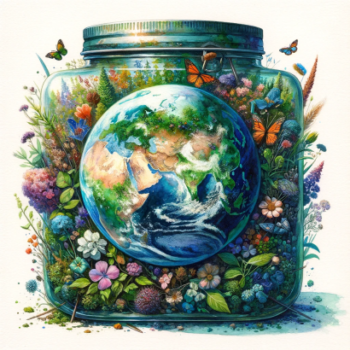
This artwork, a stunning portrayal of our new set of artworks, part of the “Earth in a Jar” project, encapsulates a world brimming with life, reflecting a microcosmic garden that emphasizes the diversity and interconnectedness of our planet’s ecosystems. At first glance, the image strikes with its vibrant juxtaposition of color and life, an Edenic representation that resonates with the beauty and complexity of Earth.
The globe, central and commanding, is rendered with a hyperrealistic touch, its continents and oceans painted with such detail that one could almost see the rise and fall of its varied landscapes. This Earth is not a static sphere but a dynamic entity, with swirling blues and greens that depict a living, breathing organism, the heart of our existence. The glass jar, despite its transparent quality, suggests a boundary, an artificial enclosure that both protects and isolates.
Surrounding the Earth is an abundance of flora, a rich tapestry of biodiversity. Flowers bloom in profusion, their petals a spectrum of hues—soft lavenders, deep purples, fiery reds, and the purest of whites. They are not mere embellishments; each flower, each leaf is a testament to the delicate balance of ecosystems that sustains life. The blossoms’ intricate details, from the veins in their petals to the dew on their stems, are a triumph of artistic precision, inviting us to contemplate the intricate beauty of the natural world.
Fluttering around this floral paradise are butterflies, those ethereal creatures of transformation. They are not only aesthetic additions but symbols of change and the fragile dance of life and environment. Their wings catch the light, a spectrum of color that mirrors the flowers they visit, embodying the symbiotic relationships that bind all living things.
The juxtaposition of the Earth, vibrant and full of motion, with the static, silent glass is a poignant commentary on humanity’s impact on the environment. The jar, with its rusted lid and the subtle patina of age, contrasts with the timeless vitality of its contents. It speaks to the human desire to preserve and control, even as it unwittingly leads to isolation and detachment from the natural order.
The spillage of color and life at the base of the jar, where paint seems to dissolve into raw, uncontained splashes, hints at nature’s indomitable spirit, its refusal to be confined. This is where the artwork whispers its most profound message: life, in all its diversity and splendor, cannot be contained. It overflows, it reaches out, it connects.
In all, this piece is a celebration of life’s exuberance and a subtle critique of our propensity to segregate and compartmentalize. It invites viewers to reflect on the paradox of human guardianship of the Earth—our simultaneous capacity for protection and destruction. It is an artwork that speaks volumes not just visually but philosophically, about the beauty of biodiversity and the importance of breaking barriers, both literal and metaphorical, to honor and preserve the interconnected web of life.
Artwork 2: Forest Embrace: The Earth’s Lush Mantle
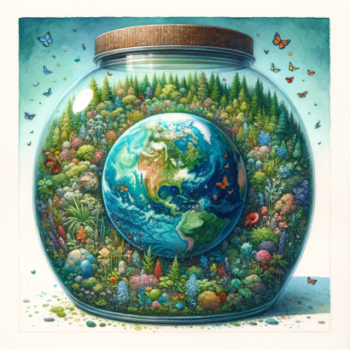
The second image in his set of artworks, part of our series, “Earth in a Jar,” presents a poetic and verdant tableau, a lush garden encapsulating the globe. This masterful piece of art is a serene depiction of biodiversity, encapsulated within the confines of a jar, symbolizing both the fragility and resilience of our planet.
In this portrayal, Earth is a radiant jewel, a richly textured sphere that commands the eye with its detailed rendering of land and sea. The continents are not mere shapes but living tapestries of terrain, inviting close examination of the varied environments that sustain life. The vibrancy of the colors used for the oceans, a mixture of turquoise and deep blue, evoke a sense of depth and vastness, reminding us of the unexplored mysteries that lie within our world’s waters.
Surrounding the Earth is a forest in miniature, a celebration of the planet’s flora. The trees and plants are depicted with exquisite attention to detail, creating a sense of depth and abundance that is almost tactile. One can almost smell the pine and feel the cool shade provided by the dense canopy. This forest is not silent; it is abuzz with life, as seen in the delicate insects that hover and flit about the scene. Each butterfly, each bee is a brushstroke of life, vital pollinators that sustain the natural cycle of growth and renewal.
The glass jar that houses this ecosystem is more than a vessel; it is a lens through which we are invited to examine our own relationship with nature. The clarity of the glass contrasts with the rich complexity within, a metaphor for the transparency with which we must view our impact on the world. The lid of the jar, wooden and sturdy, is a reminder of the barriers we erect between ourselves and the natural world, a barrier that can be both protective and restrictive.
At the periphery of the image, the background fades into a soft watercolor blue, a canvas that hints at the infinite space beyond the jar. It suggests that while the Earth is our home, it is but a part of a larger cosmos, a piece of an intricate puzzle that extends far beyond our comprehension.
What is particularly striking about this image is the sense of peace it exudes. Despite the theme of confinement, there is no sense of suffocation. Instead, the Earth and its surrounding garden seem to rest in harmony, a self-contained world that functions as a whole. It is a reminder that even within boundaries, there is the possibility for growth, diversity, and life.
This artwork is an invitation to ponder the balance between preservation and freedom, the delicate interplay between humanity’s desire to protect and the need to let nature run its wild course. It is a visual dialogue about conservation and interaction, an appeal to recognize our role not as masters but as part of a larger ecological symphony.
In sum, this piece is both a celebration of Earth’s splendor and a quiet plea for mindfulness. It asks us to consider the impact of our actions on the planet’s complex web of life and to strive for a symbiosis that nurtures and sustains all forms of existence.
Artwork 3: Aquatic Harmony: Depths of Diversity
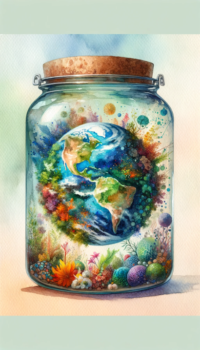
The third image in this set of artworks, part of the “Earth in a Jar” series is a lyrical and aquatic interpretation of our planet’s biodiversity. This artwork is a deep dive into the essence of life, with Earth floating in a jar filled with elements reminiscent of a coral reef teeming with marine life.
At the heart of the composition is Earth itself, portrayed with a remarkable blend of realism and fantasy. The continents, painted in lush, verdant greens and arid browns, are interspersed with sapphire oceans that glimmer with the mysteries of the deep. The planet is alive, dynamic, with swirling clouds that give a sense of the atmospheric movements that sustain life on this blue marble.
The jar serves as an aquatic vessel, a microcosm of ocean life with a variety of corals, anemones, and marine flora. The biodiversity is rich and fantastical, with a color palette that extends beyond the usual blues and greens of the ocean into vibrant oranges, purples, and reds. Each organism is a burst of color, a unique shape, a symbol of the Earth’s endless creativity. The flora and fauna seem to dance in an unseen current, a ballet of life that plays out beneath the waves.
The rusted lid of the jar speaks of the passage of time, the weathering of human endeavors against the backdrop of nature’s endurance. It suggests a barrier that is not impermeable, a reminder that while we may seek to contain nature, it is ultimately beyond our control.
The watercolor wash that forms the background adds to the dreamlike quality of the piece. The gentle gradients evoke a sense of calm, like gazing into the horizon where sky meets water, a metaphor for the boundless possibilities and the unknown that lies ahead.
In this image, the jar is not just a container but a looking glass into the depths of our planet’s heart, the oceans. It asks us to consider the unseen, the unappreciated, and the underestimated. It is a call to remember that beneath the surface, there is a world as vital and complex as the one we walk upon.
The composition is an elegant balance of color, form, and concept. It reminds us that the Earth is more than land and sky; it is also the vast and varied life beneath the sea. It underscores the importance of preserving our planet’s waters, the wellspring of biodiversity that nourishes and sustains all life.
In essence, this artwork is a celebration of the aquatic world, a reminder of the beauty that exists within the depths, and a call to action to protect this precious resource. It is both a tribute to the resilience of life and a poignant commentary on the fragility of ecosystems in the face of human impact.
Artwork 4: Conservatory Sphere: Preserving Nature’s Mosaic
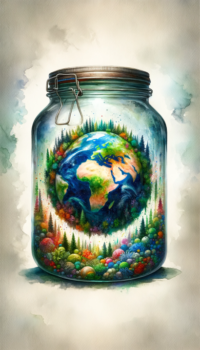
The final piece in this set of artworks, part of our “Earth in a Jar” collection offers a captivating blend of terrestrial majesty and botanical wonder, encapsulated within the confines of a traditional glass jar. This piece stands out with its classic design and metal clasp, suggesting an old-world charm and timelessness.
Center stage is our planet, a luminous orb rich with color and life, floating within the jar. The earthy tones of the continents are vibrant and warm, set against the cool blues of the oceans, creating a visual symphony that captures the eye and the imagination. The artistry with which the globe is rendered is exquisite, highlighting our world’s natural beauty and suggesting a preciousness that must be treasured.
Encircling the Earth is an array of plant life, a miniature forest that seems to breathe with the pulse of life. The diversity of the flora is remarkable; from the towering conifers to the tiniest of mosses, each species meticulously detailed and vividly colored. This botanical belt is not merely decorative; it is symbolic of the rich tapestry of life that our planet nurtures.
The jar itself is rendered with a clarity that belies its solid form, a transparent boundary that both showcases and separates the world within from the world without. The metal clasp, firmly secured, is both protective and restrictive, a metaphor for the human desire to preserve and control the natural world.
The watercolor background wash, fading from the stark white of the paper into a soft, dreamy haze, provides a delicate contrast to the detailed artwork within the jar. It suggests a vastness beyond the glass, a world that is waiting to be explored, understood, and respected.
This image speaks to the interplay between humanity and nature. The jar, a human artifact, contains a world that is both part of us and beyond us. It is a reflection on our role as stewards of the Earth, a reminder of the balance we must strive to maintain between harnessing nature’s gifts and preserving its wild heart.
The artwork invites contemplation on the fragility of our environment and the need for conservation. It is a visual narrative that encapsulates the beauty of biodiversity and the importance of safeguarding it for future generations. It is both a call to action and a love letter to the planet, urging us to see Earth not as a resource to be exploited, but as a garden to be tended with care and reverence.
With this, we complete the artistic descriptions for the four artworks. Each description has aimed to capture the essence and the message of the artwork while provoking thought on the theme of biodiversity and our place within it.
Summary:
This new set of artworks, part of the “Life in a Jar” project, presents a series of artworks that act as windows into the soul of our planet, a soul that is as vibrant as it is vulnerable. The images, rich with symbolism and artistry, showcase the Earth’s biodiversity, each brimming with life and color, each a story of interconnectedness and balance. From the dense foliage of ancient forests to the kaleidoscopic lifeforms of the ocean’s depths, these artworks capture the essence of life’s intricate web. Yet, each living, breathing scene is contained within the confines of a jar, a representation of humanity’s often compartmentalized approach to nature.
This visual metaphor challenges the viewer to reflect on the dichotomy of preservation versus captivity. It illustrates how, in our attempt to protect, we may inadvertently isolate, how in seeking to understand, we may unknowingly separate ourselves from the larger narrative of nature. The biodiversity within each jar is a microcosm of the Earth, a reminder that every species, no matter how small, plays a pivotal role in the health of our planet.
The set of artworks also poses critical questions about the impact of our actions and the legacy we wish to leave. It is a meditation on responsibility—our collective duty to nurture and safeguard the natural world, to ensure that the lushness captured in these jars is not a mere remnant of what once was but a living testament to what can flourish when care and respect guide our actions.
As we journey through these artworks, we are reminded of the inherent value of every life form, the beauty of diversity, and the importance of ecological stewardship. The “Life in a Jar” series is not just a portrayal of Earth’s splendors; it is an invitation to an ongoing dialogue about our relationship with the environment and our pivotal role in its future.
Conclusion:
As we reach the end of this new set of artworks, part of the “Life in a Jar: An Artistic Examination of Social Isolation” project, we are left with lingering thoughts and emotions stirred by the profound artworks we’ve encountered. These pieces do not merely represent the Earth in its resplendent diversity; they are a mirror reflecting the paradoxes of human engagement with the natural world. The jars, while illustrating the concept of isolation, also symbolize the delicate boundary we navigate in our relationship with the environment—a boundary that both contains and separates, that protects yet also restricts.
This artistic journey compels us to confront the self-imposed confines of our own making and to consider the broader implications of our actions. It is a call to expand our perspective, to dissolve the glass walls that limit our understanding and interaction with the natural world. In recognizing the interconnectedness of all life, we find the path to true sustainability, a harmonious existence that honors the intricate dance of biodiversity upon which we so profoundly depend.
As we part with the images of Earth ensnared within glass, may we carry forward the message they impart—a message of unity, empathy, and collective responsibility. Let us step out from the isolation of the jar into the open garden of collaborative stewardship. May these artworks serve as a catalyst, inspiring us to embrace a future where we live not as separate entities but as integral parts of a shared, thriving ecosystem.
In embracing this vision, we acknowledge that the true measure of our progress is not found in the dominion over nature but in our harmonious coexistence with it. “Life in a Jar,” therefore, is more than an exhibition of artistic expression; it is a testament to the beauty of life unjarred and a pledge to a legacy of environmental empathy and action that we must all endeavor to fulfill.
With this conclusion, we encapsulate the essence and ambition of “Life in a Jar.” It is hoped that these words resonate and foster a continued dialogue about our role within the natural world and the steps we can take to ensure a vibrant and biodiverse future.
Support the Project:
The “Life in a Jar: An Artistic Examination of Social Isolation” project transcends the boundaries of art, inviting us into a deeper conversation about our planet and our place within it. We can all play a part in sustaining this profound narrative. Here are ways to support the project:
- Financial Contributions: Consider making a financial contribution to the project. Your donations will fuel the continuation of this creative exploration and help bring more themes to life. Every donation, big or small, makes a difference and allows the artists to delve deeper into this critical discourse.
- Artwork Acquisition: Each painting in the “Earth in a Jar” series is more than an image; it’s a story, a dialogue, a piece of a larger puzzle. By purchasing an individual artwork or a complete set, you not only become a custodian of this tale but also support the artists and their vision directly. These pieces are not just decor; they are conversations starters, heirlooms, and legacies.
- Join the Dialogue: After reading about the “Earth in a Jar” artworks, start a discussion with friends, family, or online communities. Share your thoughts, feelings, and insights. The conversation that begins in contemplation can lead to action and awareness, which are pivotal in addressing the themes of isolation and environmental responsibility.
- Spread the Word: If the “Life in a Jar” project resonates with you, become an advocate for its vision. Share articles, posts, and images on social media. Invite others to join the project community, to experience the art, and to become part of the growing conversation. The more we talk about these issues, the more we can do to address them.
- Host an Exhibition: If you have the means or connections, consider hosting an exhibition of the “Earth in a Jar” series in your local community center, gallery, or school. Physical exhibitions can bring people together and create a space for dialogue and connection. Please contact us to get started.
- Volunteer Your Skills: Are you a writer, a social media influencer, or an event organizer? Lend your skills to the project. By offering your expertise, you can help amplify the project’s message and reach a wider audience.
In whatever way you choose to support, you become part of a collective effort to not only appreciate the profound beauty of our world but to also preserve it. Together, through art and dialogue, we can inspire change and foster a more connected and conscious global community.

